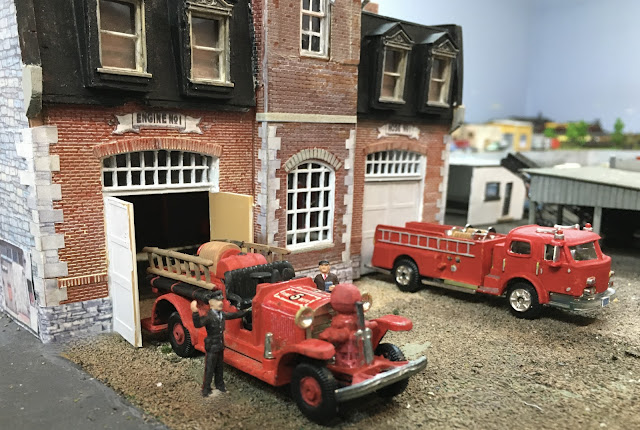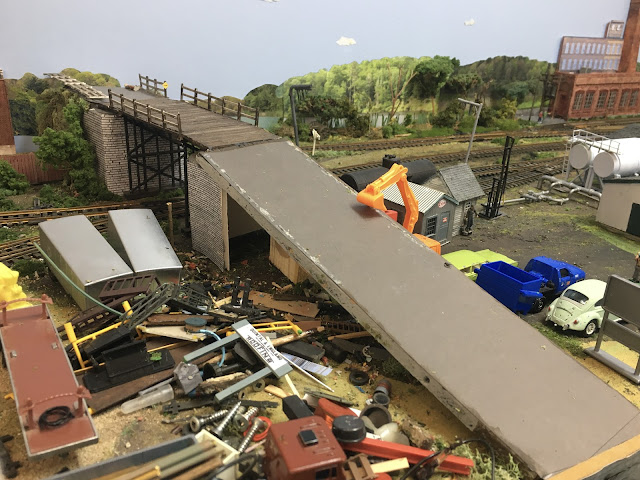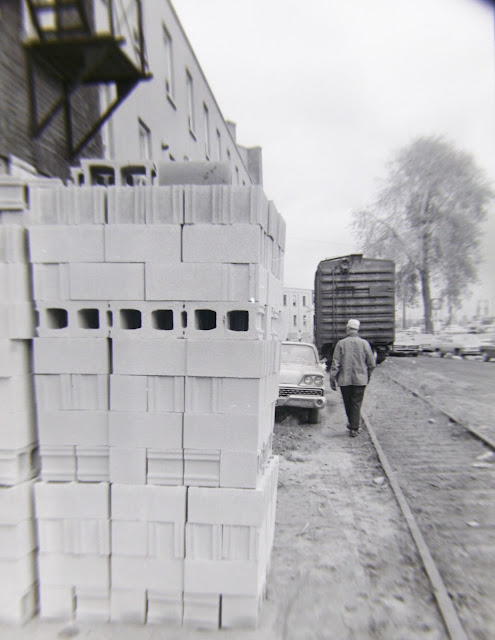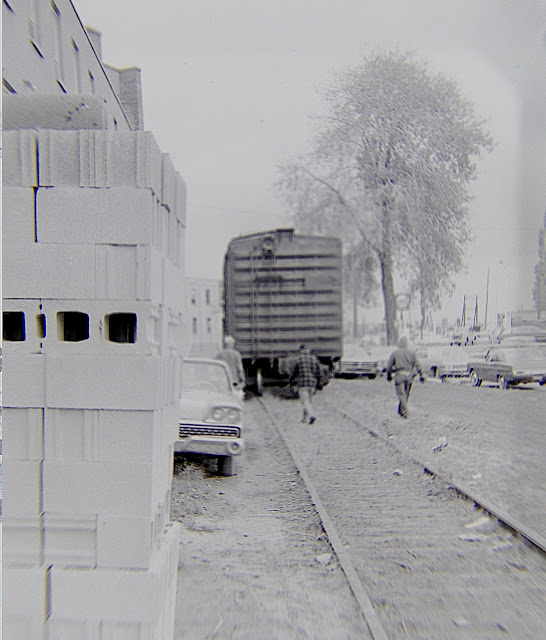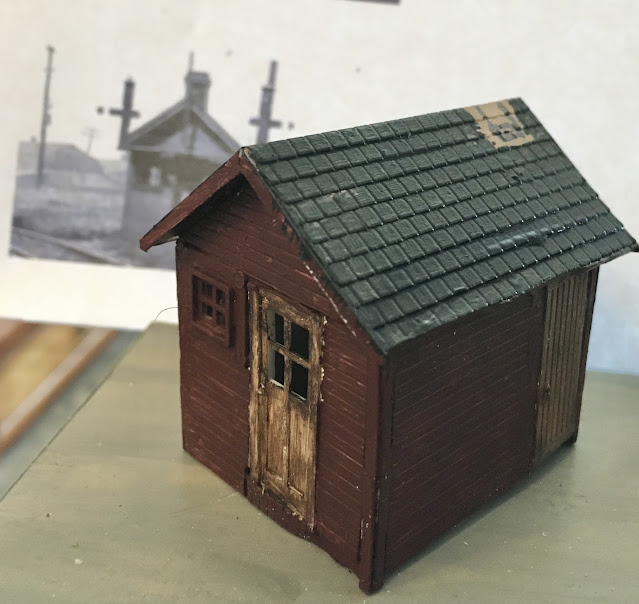
Kingston's Hanley Spur
Monday, 31 March 2025
Modelling Kingston Emergency Vehicles

Sunday, 23 March 2025
River St. Bridge Redux
After already 'redux-ing' the diamond crossing of CP and CN under the River Street bridge, it's now time to improve my modelling of the aforementioned bridge. This was brought about by my grandsons' love of driving vehicles up and over the bridge when they visited my layout. The railings were the first to go, and having moved the scrap yard to the left of the bridge and considered expanding Anglin's yard into that space, I took a look at the topography.
Both railways' lines under the bridge are in a depression, and the CP was particularly poorly-drained and prone to flooding that made the ballast and ties sub-optimal. CN seemed to have a little better ballast and roadbed. My bridge, by contrast, arises out of complete flatness, so some scenic remodelling would be of primary importance in dealing with the bridge's approaches and abutments.
First, I copy-paste-printed several images of the bridge for modelling inspiration, three views looking south and two looking north (below). The drawback to the top four images is that they show the appearance of the bridge after the 1970 rebuilding. A concrete foundation was poured, underpinning the vertical wooden bridge piers and the road approaches. Comparing that to the fifth image, the roughness of the limestone, the gap where the bridge was raised during WWII, and the stone/vegetation of the supports become apparent. I was modelling circa 1970, but now I've backdated that to circa 1966, so I need to reflect that fifth image.
I'll post my progress here as the rebuild evolves...
The first step was an unexpected one. I realized I had to reverse the direction of the Queen City Oil spur to preserve it in the face of the re-scenicking. That's OK because this would the direction it would have been, a trailing-point spur when heading north. Current underneath, new arrangement taking shape on top:A New Blog about Kingston Transit!
But that's just the first few coins in the fare-box. Watch for more history and stories of Kingston's history 'on the buses', definitely an under-represented part of Kingston's multi-faceted history!
Saturday, 15 March 2025
John Mayell's Memories of the CN Switcher
 This memory train keeps on running through some recently-published posts. First, I published a post on that 'tight squeeze' CN switching puzzle which then led to a correction to the original Whig captioning by fellow rail enthusiast and former Kingston resident John Mayell. That in turn led to a post on 40-year CN employee Ron Sturgess. Then, that post unlocked some further memories from John Mayell and led to the creation of this post!
This memory train keeps on running through some recently-published posts. First, I published a post on that 'tight squeeze' CN switching puzzle which then led to a correction to the original Whig captioning by fellow rail enthusiast and former Kingston resident John Mayell. That in turn led to a post on 40-year CN employee Ron Sturgess. Then, that post unlocked some further memories from John Mayell and led to the creation of this post!Thursday, 13 March 2025
CN 40-year Employee - Ron Sturgess
In a previous post, I included a miscaptioned Whig photo showing CN conductor 'Ron Stevens'. I heard from former Kingston resident and rail enthusiast John Mayell, who suggested the conductor's name was likely Ron Sturgess. It became apparent that John was correct. One thing, as it often does, led to another...
Ron Sturgess ran unsuccessfully for Kingston alderman in 1978, 1982 and 1985. He also noted his belief in the importance of representing the area one lives in, in this case Rideau Street in Cataraqui Ward. He'd lived at 342 since he was born. More specifically, still sleeping in the same bedroom in which he was delivered by a doctor in 1914! He was proud to note that he was the fourth generation of his family to live in the city's north end, attending Cataraqui and Robert Meek schools. Busy as a newspaper delivery boy, the papers included the British Whig, Daily Standard (amalgamated 1926), U.S. Sunday papers and even the Detroit Free Press from Morrison's restaurant.
He was often quoted in city columns sharing interesting details of his life along Kingston's industrial waterfront:
- as a boy, skinny-dipping near the [we now know] contaminated Davis Tannery property.
- his grandfather worked at the shipyards, locomotive works and tannery, apparently without any ill effects.
- he spoke well of the Davis family and how they kept 200 people employed at 25 cents per hour during the Great Depression.
- he recalled the original swamp in Swamp Ward, likely fed by a spring, also known as Caton's Pasture and years ago resembling a lake! A home for wildlife, though the fish were all in the river.
Having worked for CN for 40 years, and having survived several 'crashes', Ron Sturgess was mentioned in an amazing May 11, 1953 Whig story about a calamitous incident at the 'CN freight yards' at Place d'Armes. The above Whig photo appeared in the evening edition the same day. Talk about spot news! The caption notes that a member of the RCAMC and an unidentified workman endeavour to free driver George Bouyers of 2 Rideau Terrace. That building was adjacent to the Bajus Brewery - the incident occurred very close to his home! The unfortunate man's shoulder is just visible, and the efforts to free him took more than an hour.
Employed by KIMCO for five years, he was backing a stake-truck loaded with a 15-ton die up to the wooden unloading ramp at the 'CP siding' when the cargo shifted. It was his third attempt to reach the ramp and he braked sharply on an incline at the ramp. The wood blocking and the die slipped forward, apparently bending the frame of the truck, driving the load towards the cab and crushing the unfortunate driver between the rear of the cab and the steering column. Providing aid to the civil power, RCEME members led by WO1 Jack Seymour and a wrecker from 207 Workshop were summoned from the Barriefield army base. Five RCEME NCOs were listed in the account, as were two mechanics, all before a large crowd of onlookers and a fire crew on standby.
The CN train crew was listed as Conductor Sid Lathangue of Belleville, Engineer Bruce Lynch, Ron Sturgess (a fireman at the time and the locomotive likely a steam engine), and Brakeman Earl Barnes.
Here's the most interesting part of the story, at least to me! While the army wrecker was used to anchor the front of the buckled truck, a cable was attached to the rear of the CN crew's locomotive in an attempt to lessen the weight of the die in the back of the truck.
But...when it was decided to make use of the locomotive, three freight cars had to be 'moved off the siding' for access. The only locomotive in the vicinity was a CN one, and the crew did not wait for permission to 'switch the CP property'. The crew immediately stopped delivering their own cars to begin work on the rescue attempt.
I have to wonder if the CN crew used the mutual track across Ontario Street to gain CP rails.
Married to his wife Lola for 59 years, Ron Sturgess died in 1995.
Wednesday, 12 March 2025
Parked Car Parks Train
This little-known drama played out on October 21, 1969.
Regional Emergency Services Ambulances in Kingston
Saturday, 8 March 2025
Modelling the Ontario Street Switchman's Shanty
In the process, I decided the roof pitch was now good, but the shack was too long. I removed about three scale feet from each side and reassembled, cutting a hole in the roof for the chimney, then adding the signal superstructure and singular train-order signal blade. The whole structure was painted maroon, with the shingled roof black.
